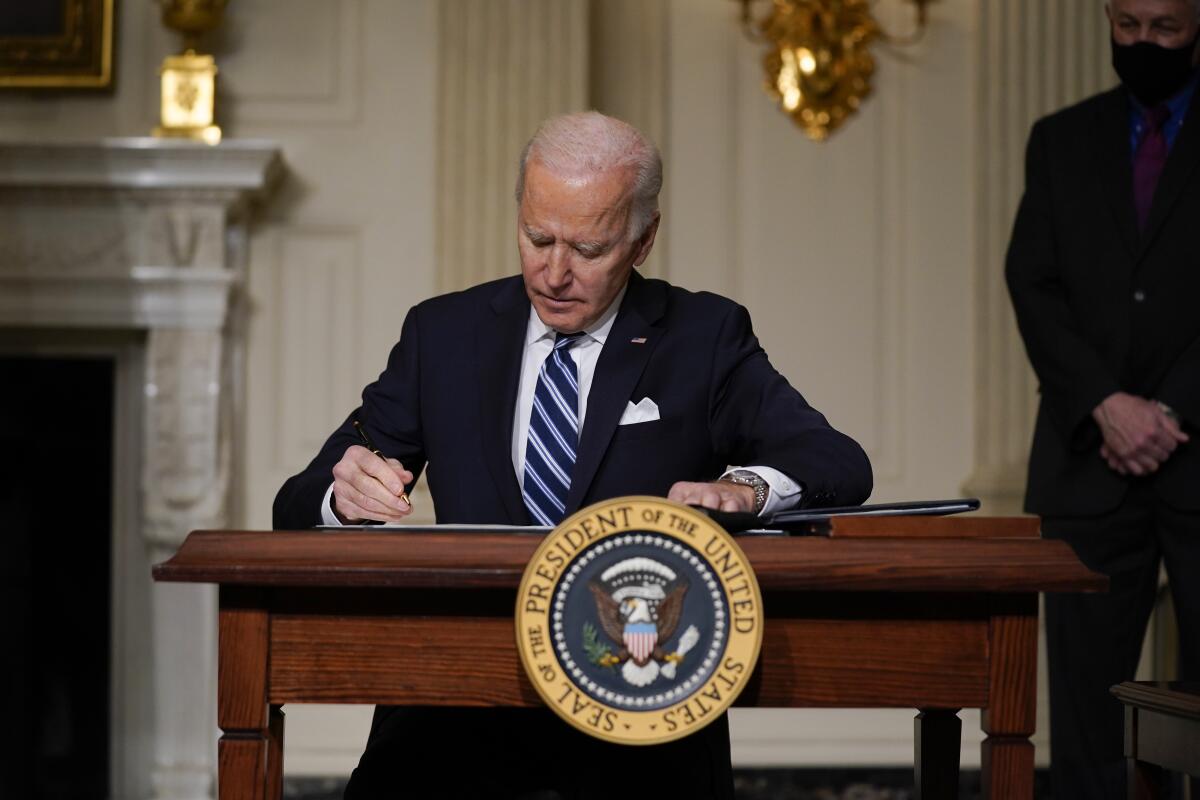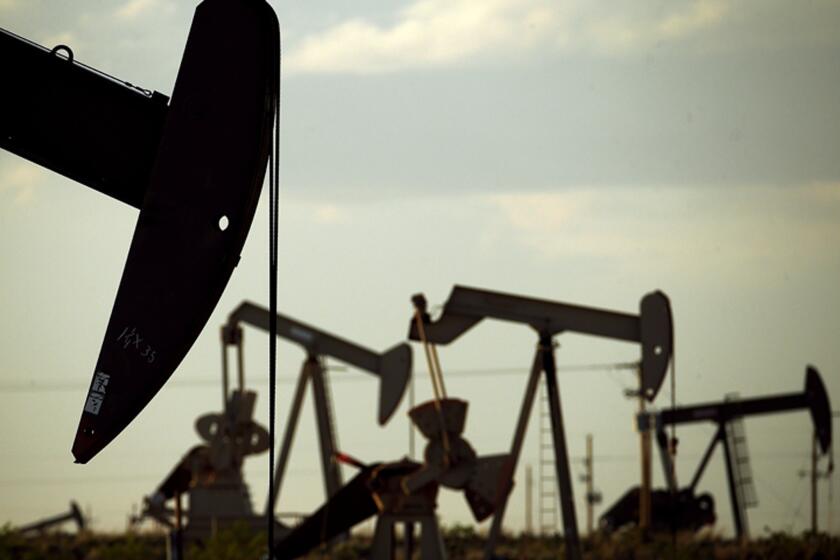How far will Biden go to fix the climate crisis? Pay attention to this gas project
- Share via
A few days after Joe Biden claimed victory in the presidential election, a San Diego company quietly asked federal officials for permission to send 5 million tons of natural gas each year across the U.S.-Mexico border to an export terminal the company hopes to build along the Gulf of California.
The facility would be Sempra Energy’s second fossil fuel export plant in Mexico. The Biden administration’s decision could offer an early preview of how aggressively it will confront the climate crisis.
Biden campaigned on a promise to transition the electric grid to 100% clean power by 2035 and to put the entire economy on a path to net zero carbon emissions by 2050. Some of his first executive actions were a moratorium on new oil and gas leasing on federal lands and a commitment to minimize pollution in communities of color.
But Biden has rejected calls to endorse a ban on fracking, the drilling technique that spurred extraction booms from New Mexico to Pennsylvania and helped make the United States the world’s largest producer of natural gas. And there are early indications his administration might look kindly on American companies eager to ship the abundant fuel overseas.
As part of her Senate confirmation process last month, former Michigan Gov. Jennifer Granholm, the president’s nominee to lead the Energy Department, said in a series of written responses that U.S. natural gas exports “can have an important role to play in reducing international consumption of fuels that have greater contribution to greenhouse gas emissions.”
That argument mirrors the gas industry’s long-standing claim that it can help fight climate change because its product burns more cleanly than coal, the most polluting fossil fuel. The American Petroleum Institute, an industry trade group, released a report last year finding that switching to U.S.-produced gas could reduce emissions from coal-fired power plants by about 50% in China, Germany and India.
“The majority of the world’s energy consumption in the next couple decades is going to come from Asia. And in the absence of reliable sources of natural gas, they’re going to continue to use their domestic coal resources,” Sempra executive Brian Lloyd said at an event Tuesday hosted by the Utah Petroleum Assn.
But even if gas is less damaging than coal, it’s a fast-growing source of planet-warming emissions — and critics say investments in gas infrastructure projects designed to operate for decades are incompatible with a stable climate.
Scientists have concluded that global emissions must be nearly halved over the next decade, then cut close to zero by 2050, to avert the worst consequences of global warming. Those consequences include deadlier wildfires, heat waves, droughts, hurricanes and floods.
Your guide to our clean energy future
Get our Boiling Point newsletter for the latest on the power sector, water wars and more — and what they mean for California.
You may occasionally receive promotional content from the Los Angeles Times.
Climate activists also say the fossil fuel industry underestimates methane leaks along the gas supply chain. Methane is a powerful heat-trapping pollutant, and the more it leaks, the less difference there is for the climate between gas and coal.
The Natural Resources Defense Council released a report in December finding that the overall climate footprint of U.S.-produced liquefied natural gas is “only modestly smaller than that of other fossil fuels.” That’s explained partly by leaks and intentional releases of methane, and partly by the large amounts of energy needed to transport and prepare natural gas for export.
“We do not want to export our bad ideas,” said Gillian Giannetti, an attorney with NRDC. “If we are recognizing that gas is not a long-term climate solution, we shouldn’t be aggressively spreading gas infrastructure across the globe.”
Sempra is a Fortune 500 company best known for its ownership of two major utilities, Southern California Gas Co. and San Diego Gas & Electric. But it has also made big investments in liquefied natural gas, including the $10-billion Cameron export terminal in Louisiana, which opened in 2019 with a launch event featuring lengthy remarks from President Trump.
Sempra’s Vista Pacifico project is one of several gas export projects now seeking approval from the Biden administration.
In an application submitted to the Energy Department on Nov. 18, a Sempra subsidiary asked for permission to send 240 billion cubic feet of natural gas to Mexico each year, most of which would be shipped overseas from a facility to be built in the Sinaloa port town of Topolobampo. The project is in early stages of development and has received little public attention.
Sempra submitted its application just two days after receiving approval from the Mexican government to build a different gas export terminal in Baja California. Reuters reported last year that Mexican President Andrés Manuel López Obrador had made approval of that facility, known as Energía Costa Azul, contingent on Sempra agreeing to build a second export terminal, to help the country sell off excess gas that it had agreed to purchase from the U.S. years earlier but no longer needed.
Kym Butler, a spokeswoman for Sempra’s liquefied natural gas subsidiary, said in an email that approval of Energía Costa Azul — which is now under construction — “was not conditioned on any other infrastructure investment in Mexico.”
But Sempra LNG executive Jim Diemer acknowledged the company is trying to help Mexico resolve its gas oversupply, with Vista Pacifico as one option. The company is looking to determine “how can we support a very important stakeholder to our West Coast [liquefied natural gas] projects,” Diemer told the Utah Petroleum Assn. on Tuesday.
The climate crisis disproportionately harms Black people, Latinos and Native Americans. But oil and gas supporters are trying to claim the moral high ground.
An Energy Department spokesman said the agency is considering Sempra’s application but doesn’t have a timetable for making a decision. Nobody submitted public comments or protests before a Feb. 8 deadline — not an unusual occurrence for an approval process that climate activists say has traditionally served as a rubber stamp on gas exports.
Federal law tasks the Energy Department with determining whether gas exports are in the public interest, although it requires the agency to approve exports to countries with which the United States has a free trade agreement. Sempra is seeking approval to send natural gas from Mexico to countries with and without free trade agreements.
It’s up to the Federal Energy Regulatory Commission, or FERC, to approve or reject the construction of gas export terminals within U.S. borders. The commission is considering several applications, including the expansion of an already approved Sempra facility in Port Arthur, Texas, and a Louisiana facility proposed by Houston-based Commonwealth LNG.
The U.S. gas export market is centered around the Gulf Coast, a longtime hub for offshore drilling, petrochemical plants and other oil and gas infrastructure. But as fracking has boomed and Asian energy demand has soared, companies have increasingly looked to ship U.S.-produced gas from the West Coast, in part to avoid paying tolls at the Panama Canal.
Pembina Pipeline Corp. has gotten closer than any company thus far to building an export terminal on the U.S. West Coast. The Federal Energy Regulatory Commission approved Pembina’s planned Jordan Cove project in Oregon last year but more recently upheld a decision by Oregon officials to block the facility over its potential harm to water quality.
The outpouring of opposition to Jordan Cove from tribal governments, environmentalists and local landowners offers a preview of the battles that could be on the horizon as the climate crisis worsens and as activists seek to hold President Biden to his campaign promises. FERC is likely to be a key battleground. Biden’s newly appointed chair, Richard Glick, has criticized the agency for approving gas export projects without greater scrutiny of their contribution to the climate crisis.
“Claiming that a project’s environmental impacts are acceptable, while at the same time refusing to assess the significance of the project’s impact on the most important environmental issue of our time, is not reasoned decision-making,” Glick wrote last year, as a member of the commission’s Democratic minority under President Trump.

As part of his ambitious climate agenda, Biden has supported policies that would drive down demand for natural gas, at least domestically. In addition to his 100% clean energy target, which would squeeze gas off the electric grid, the list of climate priorities on Biden’s presidential transition website included “direct cash rebates and low-cost financing to upgrade and electrify home appliances,” which could mean replacing gas furnaces, gas water heaters and gas stoves with electric alternatives.
Those types of policies are already advancing in California, where a 100% clean energy mandate is written into state law and more than 40 cities and counties have banned or discouraged gas hookups in new housing. Sempra’s SoCalGas subsidiary has pushed back against all-electric building codes, opposing such proposals from Los Angeles to San Luis Obispo.
Support our journalism
Your support helps us deliver the news that matters most. Subscribe to the Los Angeles Times.
But Sempra executives see gas exports as a potential growth opportunity under Biden, especially if they can make the case that the fossil fuel would help reduce emissions at home and abroad.
“Exporting [U.S. gas] to the world, we think, ultimately is going to be a compelling proposition to a Biden administration that does want to re-engage globally,” Lloyd said.
Climate activists have a different expectation.
NRDC’s Giannetti didn’t read too much into Granholm’s favorable comments on gas exports to the Senate last month. Biden’s nominee for energy secretary, Giannetti said, “is going to be looking at these issues with open eyes.”
“We’re confident that the Biden administration takes climate seriously,” she said.
More to Read
Our oceans. Our public lands. Our future.
Get Boiling Point, our new newsletter exploring climate change and the environment, and become part of the conversation — and the solution.
You may occasionally receive promotional content from the Los Angeles Times.












